Making the world my single point of failure with PostgreSQL
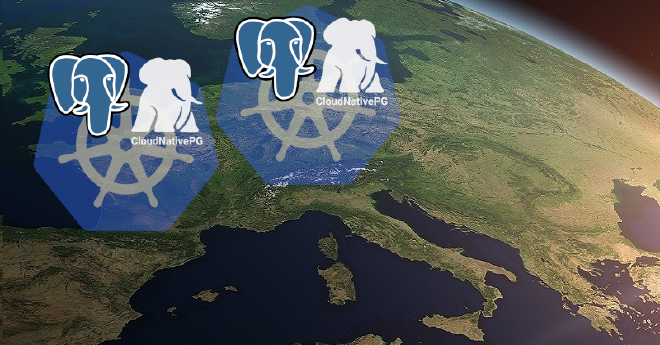
Table of Contents
The upcoming CloudNativePG 1.24 introduces a game-changing feature: the ability to declaratively manage PostgreSQL cluster switchover across cloud regions or different Kubernetes clusters. This advancement enables the seamless demotion of a primary cluster and the promotion of a replica cluster in another region without the need to re-clone the former primary. This innovation significantly revolutionises database management practices, enhancing efficiency and reliability in multi-region and multi-cluster environments.
CloudNativePG, traditionally confined to single Kubernetes clusters, is now expanded its functionality to support distributed PostgreSQL topologies across multiple regions. This enhancement leverages declarative configurations to manage coordinated promotions, ensuring a single primary instance at any time. Based on PostgreSQL’s primary/standby architecture, this setup is designed to maintain operational continuity and cater to various deployment scenarios, including hybrid and multi-cloud environments. The new capabilities significantly improve high availability and disaster recovery by mitigating the risks associated with single points of failure in PostgreSQL deployments within Kubernetes.
Among the exciting updates in the upcoming CloudNativePG 1.24 release, one groundbreaking feature stands out: the ability to declaratively control the switchover of PostgreSQL clusters across different regions — or, more precisely, different Kubernetes clusters. This feature enables the demotion of a primary cluster and the promotion of a replica cluster without the need to re-clone the former primary, streamlining and enhancing the efficiency of database management practices.
While CloudNativePG traditionally operates within a single Kubernetes cluster, we’ve expanded its capabilities to define a distributed topology for PostgreSQL clusters spanning multiple regions through declarative configuration. This distributed setup adheres to PostgreSQL’s primary/standby architecture, allowing for only one primary at any given time while offering versatility across various deployment scenarios.
This enhancement facilitates hybrid and multi-cloud deployments of PostgreSQL databases using a fully standard and open-source stack.
Building on existing features for high availability (HA) and disaster recovery (DR), CloudNativePG mitigates the risk of a single point of failure (SPoF) when running PostgreSQL databases in Kubernetes.
For a deeper understanding and to consolidate these concepts, I recommend watching the video of the talk I delivered in March 2024 at Data on Kubernetes Day in Paris. In this presentation, I delve into these topics and discuss the architectural foundations supported by CloudNativePG. I also explore the concept of making the world our single point of failure with PostgreSQL in Kubernetes, providing insights on how to easily achieve outstanding results in terms of Recovery Time Objective (RTO) and Recovery Point Objective (RPO) — fundamental goals of any business continuity solution.
Let’s now explore how these capabilities function in practice.
Real-World Scenario #
Rather than presenting a hypothetical distributed cluster spanning three continents, let’s explore a real use case in the banking sector within a single continent: Europe. Once you grasp the basic concepts, it will be easy to expand them to cover multiple regions, which I will demonstrate before concluding.
Imagine your organisation operates two Kubernetes clusters—one located in Central Europe and the other in Western Europe. These regions were chosen because they are neither too close nor too distant from each other, though their specific locations are not relevant to this discussion. Likewise, whether these clusters are private, public, hybrid, or multi-cloud does not matter here.
Each Kubernetes cluster spans three availability zones (common in public clouds, less so on-premises), and the PostgreSQL cluster follows a shared-nothing architecture (refer to “Recommended Architectures for PostgreSQL in Kubernetes” for further insights).
As part of the organisation’s business continuity plan, the primary data centre alternates its role between central and Western Europe every 3 to 6 months. This primary data centre, also known as the active centre, hosts customer-facing applications and is crucial for ensuring seamless operations.
The counterpart data centre, often referred to as the Disaster Recovery (DR) or passive Kubernetes cluster, remains on standby.
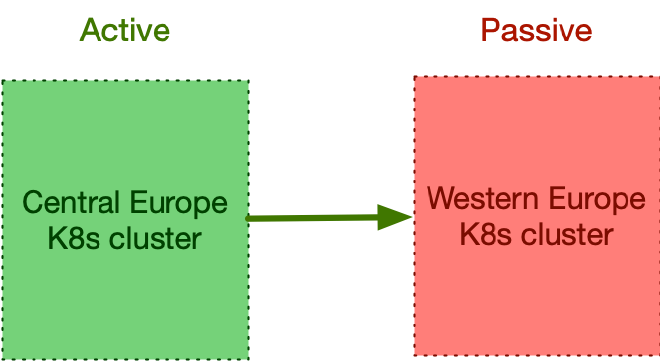
This process is known as a controlled switchover, or planned switchover, of a data centre.
Understanding the Primary Data Centre #
Within the primary Kubernetes cluster, stateless customer-facing applications operate seamlessly. These applications interact with a local PostgreSQL cluster managed by CloudNativePG, which consists of a primary node and two hot-standby replicas, ensuring high availability (HA). One of these replicas supports synchronous replication, bolstered by continuous backup mechanisms and WAL files stored in a nearby object store. We call it the primary cluster.
End users access these applications via efficient DNS routing, facilitated by
Kubernetes Deployment resources and accessible through either an Ingress
resource or a LoadBalancer service type. This setup guarantees robust and
reliable user interactions within the system.
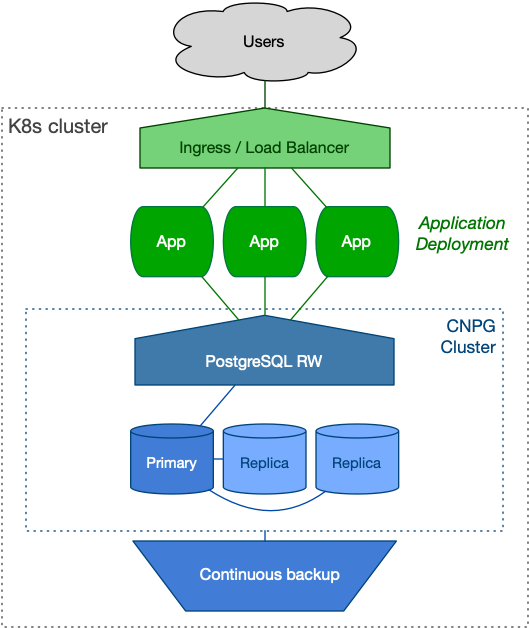
While your architecture may include additional components such as caching layers, this article focuses primarily on PostgreSQL and its direct interfacing components.
The Disaster Recovery Data Centre #
The Disaster Recovery (DR) data centre is designed to mirror the primary centre, adhering to a “symmetric” arrangement.
The objective is to ensure seamless service continuity for users during a switch to the DR centre, ideally with minimal downtime. Leveraging cloud computing capabilities allows for scaling resources dynamically. For instance, stateless application workloads can be scaled down to zero during idle periods, as depicted in the diagram below. Alternatively, the DR centre can handle read-only applications.
On the PostgreSQL side, you have the flexibility to start with a single instance or deploy a full cluster with two replicas, mirroring the setup in the primary data centre. The decision depends on cost optimisation policies and operational requirements. Ahead of planned switchovers, scaling up to two replicas is feasible.
CloudNativePG introduces the concept of a replica cluster. These are PostgreSQL clusters in continuous recovery mode, with one replica elected as the designated primary ready to assume the primary role if necessary. Other replicas remain synchronised through PostgreSQL’s native cascading streaming replication from this designated primary.
The designated primary stays synchronised with the source data centre (the primary) through continuous backup storage. It’s crucial that each PostgreSQL cluster can access the other’s object store in read-only mode. This setup typically provides a 5-minute Recovery Point Objective (RPO) out of the box, without requiring a continuous streaming connection between the clusters.
There’s more… To achieve a lower RPO, it’s recommended to establish a secure channel between the data centres and implement asynchronous streaming replication in addition to continuous backups. However, a detailed exploration of this topic is beyond the scope of this article.
Following the symmetric architecture, a replica cluster manages its own continuous backup object store directly through CloudNativePG.
The setup is illustrated in the diagram below.
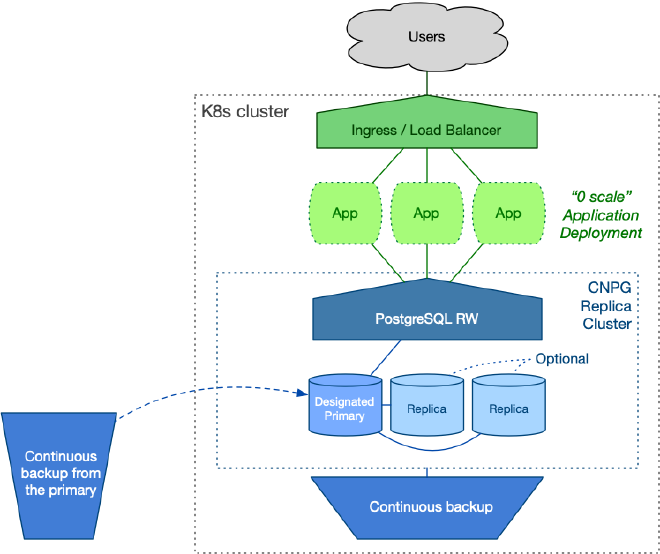
Initial setup #
The Data Centre in Central Europe #
Let’s explore the primary data centre scenario situated in Central Europe, focusing on the PostgreSQL cluster configuration.
To illustrate, let’s define the pg16-eu-central primary PostgreSQL cluster
using the Cluster resource provided by CloudNativePG:
apiVersion: postgresql.cnpg.io/v1
kind: Cluster
metadata:
name: pg16-eu-central
spec:
imageCatalogRef:
apiGroup: postgresql.cnpg.io
kind: ImageCatalog
name: postgresql
major: 16
instances: 3
minSyncReplicas: 1
maxSyncReplicas: 1
storage:
size: 100Gi
walStorage:
size: 50Gi
# Local backup object store
backup:
barmanObjectStore:
destinationPath: s3://pg16-eu-central/
# ...
# Distributed topology configuration
externalClusters:
- name: pg16-eu-central
barmanObjectStore:
destinationPath: s3://pg16-eu-central/
# ...
- name: pg16-eu-western
barmanObjectStore:
destinationPath: s3://pg16-eu-western/
# ...
replica:
primary: pg16-eu-central
source: pg16-eu-western
We use the new image catalog feature to specify PostgreSQL 16. Subsequently, we configure three instances with synchronous replication quorum, ensuring continuous data consistency (RPO = 0).
We segregate PGDATA from WAL files using distinct volumes and integrate a
local object store for continuous backups via Barman Cloud.
IMPORTANT
This setup is intentionally simplified, recognising that
configurations may vary across environments and object store technologies.
However, it’s crucial to note that each Kubernetes cluster (Central and
Western Europe) operates independently, adhering to the principle of
shared-nothing architecture.
Next, we focus on defining the distributed topology of the PostgreSQL cluster. We start by declaring the external clusters section, emphasising the importance of defining your database’s distributed topology within your infrastructure-as-code configuration for long-term clarity and maintainability.
I recommend declaring an identical externalClusters section in all Cluster
resources participating in a distributed topology. This approach offers a clear
understanding of the entire topology at a glance. Specifically, any cluster
mentioned in the replica section (such as primary, source, or self)
must be defined in the externalClusters section.
The replica.primary directive instructs CloudNativePG to designate this
Cluster as the primary within a distributed topology that includes the
Western Europe counterpart. When the cluster’s metadata.name matches
replica.primary, CloudNativePG identifies this cluster as the primary.
Specifically, the match is made against replica.self if it is defined,
otherwise, it falls back to metadata.name.
The replica.source option outlines the topology when this cluster is no
longer the primary, designating the western cluster as the replication
source. In our example, we specify how pg16-eu-central can connect to
pg16-eu-western when it acts as a replica, using a barmanObjectStore
for base backups and WAL archives.
There’s more…
You can also use connectionParameters to establish a
streaming replication connection to the other PostgreSQL server, specifying
authentication methods such as TLS certificates or passwords. However, a
detailed discussion of this topic is beyond the scope of this article.
As a best practice, consider scheduling your backups and immediately initiating one to expedite replica setup in the Western Europe data centre. For instance, a daily backup can be scheduled as follows:
apiVersion: postgresql.cnpg.io/v1
kind: ScheduledBackup
metadata:
name: pg16-eu-central-backup
spec:
schedule: '0 0 0 * * *'
backupOwnerReference: self
cluster:
name: pg16-eu-central
immediate: true
The immediate option ensures a full backup is taken immediately upon
instantiating the ScheduledBackup object.
In summary, this configuration ensures a secure PostgreSQL cluster with robust backup mechanisms, leveraging WAL archiving and daily backups. CloudNativePG provides high availability through hot standby replicas and automated failover within the Kubernetes environment.
The Data Centre in Western Europe #
Let’s move to the DR data centre located in Western Europe, by defining
the pg16-eu-western replica cluster using the Cluster resource provided by
CloudNativePG, abiding by the principle of symmetry:
apiVersion: postgresql.cnpg.io/v1
kind: Cluster
metadata:
name: pg16-eu-western
spec:
imageCatalogRef:
apiGroup: postgresql.cnpg.io
kind: ImageCatalog
name: postgresql
major: 16
instances: 3
minSyncReplicas: 1
maxSyncReplicas: 1
storage:
size: 100Gi
walStorage:
size: 50Gi
# Local backup object store
backup:
barmanObjectStore:
destinationPath: s3://pg16-eu-western/
# ...
# Distributed topology configuration
externalClusters:
- name: pg16-eu-central
barmanObjectStore:
destinationPath: s3://pg16-eu-central/
# ...
- name: pg16-eu-western
barmanObjectStore:
destinationPath: s3://pg16-eu-western/
# ...
replica:
primary: pg16-eu-central
source: pg16-eu-central
You will notice that most of the configuration file is identical, with only a few unique and defining options:
- The name of the cluster
- The details for the local backup object store
- The source of the replication (Central Europe)
Since replica.primary does not match the cluster’s name, CloudNativePG treats
it as a replica cluster and uses replica.source to determine from which
external cluster to expect transactional changes via physical replication—in
this case, through the WAL archive in the Central Europe object store
(simplified as s3://pg16-eu-central/).
In this configuration, applications write to the Central Europe cluster, and changes to PostgreSQL are continuously recorded in the local WAL (Write-Ahead Log) file. The WAL file is closed either when it reaches its maximum capacity or every five minutes. Subsequently, it is archived in the Central Europe object store and regularly accessed by the designated primary in the replica cluster using the WAL restore command. This robust capability, known as WAL shipping, has been a foundational feature of PostgreSQL for over 20 years—a testament to the contributions of my dear and dearly missed friend, Simon Riggs.
One of the highlights of this architecture is that after the designated primary replays the WAL file, it is archived in the Western Europe data centre. This setup inherently provides PostgreSQL continuous backup across two different regions, regardless of the underlying storage solution.
Let’s imagine this setup has been in production for several months. Now, the organisation needs to execute a controlled switchover to the other data centre as part of its business continuity plan.
It’s time to see the controlled switchover in action.
Demotion of the Primary Cluster #
Since there can only be one primary data centre at a time, the current primary must be demoted before its role is passed to another data centre during a controlled switchover.
Thanks to CloudNativePG’s integration with PostgreSQL, this operation is now straightforward.
To initiate the demotion, simply update the replica.primary field in the
pg16-eu-central cluster configuration to point to pg16-eu-western:
replica:
primary: pg16-eu-western
source: pg16-eu-western
When this change is applied, CloudNativePG understands that the
pg16-eu-central cluster is no longer the primary and demotes it to a replica
cluster, awaiting changes from its new source, the pg16-eu-western cluster
(which remains a replica).
As is typical with PostgreSQL, this operation involves downtime for write operations since there is no primary across the entire distributed cluster.
During the transition from primary to replica cluster, CloudNativePG performs two critical operations:
- Archives the checkpoint REDO WAL file, which includes the shutdown
checkpoint, as a
.partialfile in the WAL archive. - Generates a
demotionTokenin theClusterstatus. This token is a base64-encoded JSON structure retrieved frompg_controldata, containing essential information such as the database system identifier, latest checkpoint’sTimeLineID, latest checkpoint’s REDO location, latest checkpoint’s REDO WAL file, and the time of the latest checkpoint.
The designated primary in Central Europe is now eagerly awaiting a new WAL file
from the WAL archive of pg16-eu-western. However, as previously mentioned,
pg16-eu-western is currently still a replica and cannot yet produce a new WAL
file.
Let’s explore how we can resolve this catch-22 situation.
Promotion of the Replica Cluster #
Now, it’s time to promote the replica cluster in Western Europe, but it must be done correctly: we require the demotion token from the former primary cluster.
Connect to the Central Europe Kubernetes cluster and retrieve the
demotionToken from pg16-eu-central with:
kubectl get cluster pg16-eu-central \
-o jsonpath='{.status.demotionToken}'
If you’re curious, you can inspect the content using the following command:
kubectl get cluster pg16-eu-central \
-o jsonpath='{.status.demotionToken}' | base64 -d | jq
Next, update the pg16-eu-western cluster configuration as follows:
replica:
primary: pg16-eu-western
source: pg16-eu-central
promotionToken: <DEMOTION_TOKEN_VALUE>
The changes to the primary and promotionToken fields must be made
simultaneously. Caution: omitting the promotion token will trigger a failover,
requiring a rebuild of the former primary.
Upon receiving these changes, CloudNativePG initiates a smooth promotion of the replica cluster to a primary cluster. Initially, CloudNativePG waits for the designated primary to replicate all WAL information until reaching the specified LSN (contained in the token). Once this point is reached, the promotion process begins. The new primary switches timelines, archives the history file and new WAL in the archive, thereby unblocking the replication process in the Central Europe cluster (now operating as a replica).
Et voilà, les jeux sont faits!
Additional Topics #
The example presented in this blog article covers only a subset of the potential scenarios enabled by this powerful capability. Explaining this capability is complex, so my goal was to illustrate it with a simple yet realistic scenario.
Now that you understand how it functions, you can expand upon it by adding a
third Kubernetes cluster and introducing a circular topology. For instance,
consider adding pg16-eu-south into the mix:
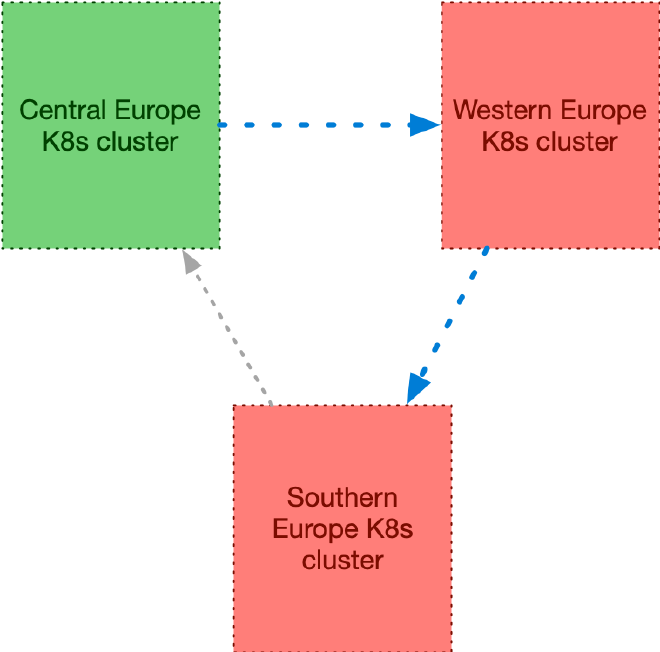
A conceptual definition of the externalClusters section across all three
clusters might resemble this example (with identical configuration in each):
externalClusters:
- name: pg16-eu-central
barmanObjectStore:
destinationPath: s3://pg16-eu-central/
# ...
- name: pg16-eu-western
barmanObjectStore:
destinationPath: s3://pg16-eu-western/
# ...
- name: pg16-eu-south
barmanObjectStore:
destinationPath: s3://pg16-eu-south/
# ...
The replica.source field would then be configured as follows:
pg16-eu-southforpg16-eu-centralpg16-eu-centralforpg16-eu-westpg16-eu-westforpg16-eu-south
Remember, you can enhance this setup by configuring streaming replication in the external cluster definitions, allowing PostgreSQL to rely on both streaming and WAL archive channels for enhanced resilience.
Moreover, if you wish, you can expand this topology by incorporating additional clusters outside of Europe.
Conclusions #
CloudNativePG represents a significant advancement as the first tool capable of achieving a controlled switchover across data centres entirely through declarative methods, leveraging the WAL archive alone. This process can be streamlined into three key steps:
- Update the configuration of the primary cluster to demote it and designate a new primary in the distributed topology.
- Retrieve the demotion token from the status of the demoted cluster.
- Update the configuration of the replica cluster to promote it, specifying the promotion token.
These operations seamlessly integrate into GitOps and Infrastructure as Code (IaC) practices, ensuring consistency and reliability in managing PostgreSQL clusters.
Looking ahead, I anticipate Kubernetes cluster management tools will incorporate native support for CloudNativePG’s controlled switchover capabilities across clusters, enhancing their operational capabilities.
This innovative approach to defining distributed PostgreSQL cluster topologies ensures robust adoption in Kubernetes environments. It offers a sustainable deployment solution not only for public and private clouds but also for hybrid and multi-cloud scenarios, leveraging Kubernetes and PostgreSQL’s standardised foundational layers. It is up to you to define your single point of failure: the storage, the data centre, the region, the continent, and, why not, the world!
In my next blog article, I will continue this topic by providing a repeatable example on AWS EKS. In the meantime, you can test the feature using the latest snapshot of CloudNativePG with my playground for AWS EKS. Stay tuned for the next release of CloudNativePG, and don’t miss the opportunity to participate in the release candidate program for version 1.24.0!
On a personal note, I’ve envisioned adding this feature to CloudNativePG for quite some time, and I’m thrilled that it’s finally a reality. This capability is a culmination of our extensive multi-year experience in running PostgreSQL infrastructure and assisting customers worldwide in managing their large-scale databases. I eagerly await feedback from users worldwide. I extend my heartfelt thanks to my colleagues at EDB — particularly Armando, Francesco, Leonardo, and Marco (in alphabetical order) — who developed this feature with dedication and expertise.